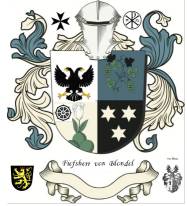



Feifdom Blondel InsigniaThe Insignia of the Fief Blondel should be used with the utmost respect.
The Arms below belong to the present Seigneur. There are 2 Blondel Fiefs, One owned by the Crown and the other Private. ANCIENT ARMS of THE SEIGNEUR OF FIEF BLONDEL - The armiger holds The Seigneury of Thomas Blondel; a feudal Normal title of Guernsey dating back to XI century.
The Bailiwick of Guernsey The Bailiwick of Guernsey is a dependency of the British crown in the Channel off the French coast. In addition to the island of Guernsey itself, it also includes Alderney, Sark, Herm, Jethu, Brecqhou, Burhou and other small islands. With Jersey, they form the archipelago known as the Norman Channel Islands. Guernsey translates as "Guernsey" in English. Guernsey has an area of 62 km². The landscapes are contrasted. Bordered by cliffs on the south coast (altitude 100 m) the island gradually decreases as one approaches the north coast. The spectacular, rugged landscapes of the south coast give way to the meadows and rolling hills of the interior, while to the north, the low, sandy coast is indented with well-sheltered bays. Its capital, Saint Peter Port, is one of the liveliest and most picturesque cities of the archipelago. It is in this city that Victor Hugo lived in exile from October 31, 1855 to August 15, 1870. He will return there three times , in 1872 where there is one year, one week in April 1875, and almost four months in 1878. ARMS The coat of arms of Fiefs and Island of Guernsey is composed of the coat of arms of England and that of Normandy. This blazon, unlike the others, incorporates a small branch at the top. It is composed of a field Gules, in which appear three lions (or leopard in heraldry) of gold and armed with azure. Above is a small branch of gold. The weapons are those of the Kingdom of England. They are identical to those used by Jersey (with the exception of the small gold branch on Guernsey's weapons). Although used since 1290, the use of royal arms by the Channel Islands was accepted in 1907, but never officially granted FLAG The flag of Guernsey , a dependency of the British Crown, was adopted on May 9, 1985, on the occasion of the 40th anniversary of the liberation of the island. Originally, the Guernsey flag was simply the cross of St. George. This pavilion is mentioned from 1936. However, there was a confusion between this and that of England. To put an end to this, a committee was formed under the chairmanship of Sir Graham Dorey, deputy bailiff of the time, who then proposed to continue to use the St. George's Cross, adding the gold-toned cross on the banner of William the Conqueror. The civilian merchant flag is composed of the Red Ensign with the gold cross on the side. Companies that are registered and headquartered on the island may fly the Guernsey flag on their vessels when operating in waters adjacent to the Channel Islands.
The Ancient Blondel Arms Reference: http://www.armorial-register.com |
Tenures Abolition Act 1662 - Rights to Sit in Parliament Law of Ireland List of Townlands of Longford Annaly The Seigneur About Longford English Pale Lord of St. Brigit's Longford Abbey Est. 1578 Seneschal of Meath Market & Fair Court Barons News Irish Kingdoms Fishing & Dams Rights Rights of Lords & Barons Feudal Barons Styles and Dignities Lord Baron Longford Baron de Delvyn Longford Map Lord Baron of Delvin Baron of Temple-Michael Baron of Annaly Lord Conmaicne Baron Annaly Baron Lerha Granard Baron AbbeyLara Baronies of Longford Princes of Conmhaícne Angaile or Muintir Angaile Baron Lisnanagh or Lissaghanedan Baron Moyashel Moiety of Ardagh Baron Rathline Captainship of The Slewght William in the Annaly Sleaught William - Chief Annaly Grants to Delvin Baron Inchcleraun HOLY ISLAND Quaker Island Longoford CO Abbey of All Saints Kingdom of Uí Maine Baron Dungannon Baron Monilagan - Babington Lord Liserdawle Castle Baron Columbkille Kingdom of Breifne Baron Kilthorne Baron Granarde Count of Killasonna Baron Skryne Baron Cairbre-Gabhra AbbeyShrule Fiefs of the Islands Feudal Westmeath The Island Lords Fief Worship Channel Island History Fief Blondel Fief Blondel Merchandise Events Blondel and King Richard Fief Coin Feudal Guernsey Titles The Feudal System Flag & Arms Castle Site Map Disclaimer Blondel Myth Dictionary
Feudal Baron of Longford Annaly - Baron Longford Delvin Lord Baron &
Freiherr of Longford Annaly Feudal Barony Principality Count Kingdom of Meath - Feudal Lord of the Fief
Blondel of the Nordic Channel Islands Guernsey Est. 1179
Feudalherr - Fief Blondel von der Nordischen Insel Guernsey Est. 1179 *
New York Gazette ® - Magazine of Wall Street - George
Mentz - George Mentz
Counselor George Mentz Esq. - Seigneur Feif Blondel - Lord Baron Longford Annaly Westmeathwww.BaronLongford.com * www.FiefBlondel.com |




